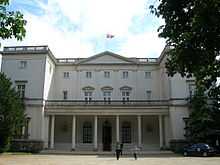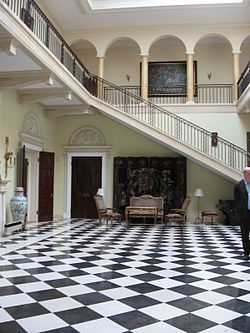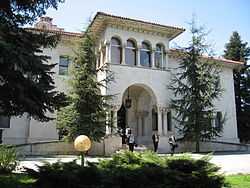Beli dvor
| White Palace | |
|---|---|
| Бели двор / Beli dvor | |
 Front entrance of the White Palace | |
| General information | |
| Architectural style | neopalladian |
| Location | Dedinje, Belgrade |
| Country | Serbia |
| Coordinates | 44°46′13.37″N 20°26′55.57″E / 44.7703806°N 20.4487694°E |
| Construction started | 1934 |
| Completed | 1937 |
| Owner | Serbian government |
| Design and construction | |
| Architect | Aleksandar Đorđević |
The White Palace (Serbian: Бели двор / Beli dvor) is a former royal residence of the Karađorđević dynasty. The palace is located in the Royal Compound, in the Dedinje neighborhood of Belgrade.[1]
The White Palace located in the same complex as the Royal Palace, the official residence of the Karađorđević royal family. The palace was designed by architect Aleksandar Đorđević, in a neo-Palladian manner inspired by the 18th century English houses such as Ditchley Park. Its interior was decorated with English Georgian and 19th century Russian antiques by the French design firm Jansen, which later decorated the White House during the administration of John F. Kennedy.[2]
History
The palace was commissioned and built with the personal funds of King Alexander I for his three son's.[1] Alexander was assassinated during a state visit to Marseille, France, the same year construction on the palace began. Supervision of construction was overtaken by the Prince Regent Paul until its completion in 1937. Queen Maria and her three sons, including the 11-year-old King Peter II, continued to reside in the Royal Palace during this time.[1] Prince Paul was the only member of the royal family to reside in the palace before the outbreak of the Second World War and invasion of Yugoslavia.
Following the end of the war, the new communist government seized the assets and property of the royal family. Beli dvor was periodically used by presidents Josip Broz Tito and later by Slobodan Milošević for official state functions and foreign visits. Milošević received U.S. envoy Richard Holbrook at the palace before the NATO bombing of Yugoslavia began, Milošević later officially resigned his presidency in front of the palace fireplace.[3]
The White Palace is open to the public visitations on weekends, during the tourist season from April to November.[4]
The Royal Compound has also participated in Tourism Fairs in Belgrade and Novi Sad and during the Days of the European Cultural Heritage.[5][6]
Art collection
The qualified tour guides at the Palace will tell any visitor that Beli dvor's notable works of art include paintings by: Piero di Cosimo, Biagio d'Antonio, Nicolas Poussin (3 works), Giovanni Cariani, Sébastien Bourdon, Albrecht Altdorfer, Titian, Rembrandt (2 attributions), Palma Vecchio (2 paintings), Carlo Caliari, Peter Paul Rubens, Simon Vouet, two paintings by Brueghel, Antonio Canaletto, Eugène Delacroix, Jean-Baptiste Carpeaux, Giuseppe Crespi, Nicolae Grigorescu, Franz Xaver Winterhalter, Eugène Fromentin, Gaspard Dughet, Richard Parkes Bonington, Đura Jakšić, Ivan Meštrović, Vlaho Bukovac and others. This collection was created by Prince Paul of Yugoslavia. Also the green and white Sèvres porcelain service was purchased by him in 1932 in Paris from the gallery Charpentier. The service once belonged to the Comte d'Artois.
Lootings and theft
Many works-of-art were looted by communist Partisans in 1944, following the liberation of Belgrade from German occupation. One of looted pieces includes Rembrandt school's painting 'Klint Tabie Maximus'.[7]
Selected works of art

- Piero di Cosimo, Forest Fire
- Domenico di Pace Beccafumi, Clelia's Escape (oil on panel, 64 cm x124cm) [8]
- Biagio d'Antonio, Madonna with Jesus and Angels
- Albrecht Altdorfer, Madonna Dream, 'Taking Maria to the Temple
- Andrea di Aloigi, The Worship of the Child (oil on panel,d.80cm,c.1500) [9]
- Palma Vecchio, The Holy Family with St. Catherine,St. John and Donor(104x167cm,c.1510)[10] and Self Portrait [11]
- Titian, Male Portrait
- Paolo Veronese Decorating Bull [12]
- Bernardino Licinio, Portrait of Noble Woman
- Giuseppe Crespi, Parable of the Prodigal Son
- Simon Vouet, Allegory composition ( 175cm x 157cm c.1640) [13]
- Nicolas Poussin, Adonis and Venus , Landscape with Three Monks (117x193cm)[14] and Landscape (drawing)
- Sébastien Bourdon, Landscape with Remains'
- Carel Fabritius attributed, Man with Flaute
- Melchior d'Hondecoeter,Different Birds
- Brueghel, Vase with Flowers
- Charles Le Brun, Macedonian Army Battle (tapestry 355 x 354 cm) [15]
- Antonio Canaletto, Channel in Venice
- Augustin Pajou, Portrait Bust of Countess di Bari (sculpture)
- Eugène Delacroix, Toilete of Algerian Woman (aquarel,35x29cm)[16]
- Alexander Roslin, Portrait of Grand Duchess Maria Feodorovna
- Ivan Aivazovsky, Walking on the Sea
- Jean-François Millet, Landscape with antique figures and beggers
- Franz Xaver Winterhalter, Portrait of Maria Alexandrovna
- Nicolae Grigorescu, Portrait of girl with red headscarf
- Emmanuel Frémiet, St.George and Dragon (sculpture bronze)
- Ivan Bilibin, The Tale of the Golden Cockerel and Fairy Tale about Emperor Sultane
- Georges Scott, Portrait of HM King Alexander I on the Horse
- Richard Parkes Bonington, Loggia of Imaginary Palace
- Félix Ziem, Grande Channel
- Jean-Baptiste Carpeaux, African Female Slave (sculpture)
- Vlastislav Hofman, Girl (1916)
- Rihard Jakopič, Girl with the lamb
- Gojmir Anton Kos, Girl
- Vlaho Bukovac, Purple Dream, The White Slave
- Paja Jovanović, Motive from Morocco and Portrait of King Alexander I Karadjordjevic
- Ivan Meštrović, Sfinga, Self Portrait, Njegos, Milos Obilic
References
- ↑ 1.0 1.1 1.2 "The White Palace". royalfamily.org. Retrieved July 12, 2013.
- ↑ James Archer Abbott, Jansen, New York: Acanthus Press, 2005
- ↑ "Čas istorije na Belom dvoru" (in Serbian). Stil magazin. Retrieved 12 July 2013.
- ↑ The Office of HRH Crown Prince Alexander II, Palaces open for visitors until 25 November 2007 (press release), Belgrade, 7 November 2007.
- ↑ The Office of HRH Crown Prince Alexander II, Palaces welcome European heritage and extended tourist season (press release), Belgrade, 11 September 2007.
- ↑ The Office of HRH Crown Prince Alexander II, Royal Compound presented at Novi Sad Fair 9–12 October (press release), Belgrade, 9 October 2007.
- ↑
- ↑
- ↑
- ↑
- ↑
- ↑
- ↑
- ↑
- ↑
- ↑
External links
| Wikimedia Commons has media related to Beli dvor. |
- Official site of the Royal Family
- Oplenac, The Mausoleum of the Royal Family
- Aerial video of the Beli Dvor
| |||||||||||||||

